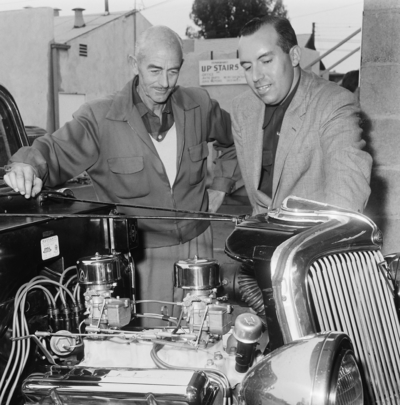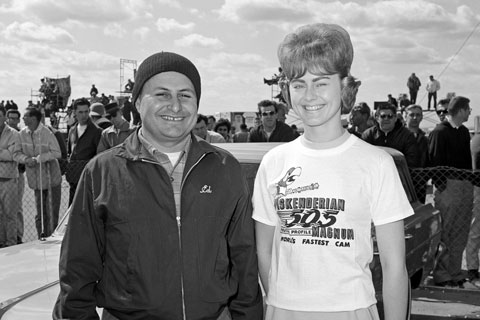SEMA News—July 2020
HERITAGE
Engine Swap, ’50s Style
By Drew Hardin
Photography Courtesy Eric Rickman, Petersen Publishing Company Archive
 |
The gentleman on the left—Winston Roche of North Hollywood, California—bought his ’34 Ford sedan as a new car. His job as a civil engineer took him all over the country, and the Ford’s trusty Flathead V8 carried him on his rounds for 20-some years, covering more than 300,000 miles in the process. By late 1956, though, the engine was just worn out, having been through several rebuilds.
Mr. Roche didn’t want to give up on the Ford. Instead, he visited Lewie Shell (at right in the photo) at Shell Motors & Parts on Wilshire Boulevard in Los Angeles for a suitable replacement engine.
Shell Motors was a fixture in the Southern California speed scene and a longstanding advertiser in Hot Rod. The magazine’s Eric Rickman produced a “photo story” for the July 1957 issue, showing the highlights of transplanting a late-model V8 into Roche’s old Ford.
Shell’s “engine emporium,” as Rickman called it, had a wide selection of overhead-valve V8s to choose from. In fact, Shell’s Hot Rod ads touted the company’s “drive-in, drive-out complete OHV8 motor custom installations” as well as a wide range of parts, available either at the shop or via mail order “anywhere in the world.”
Roche initially had his eye on a ’56 Buick V8, “but after the original Flathead had been removed and the Buick tried for size, Roche cancelled it,” Rickman wrote. “Extensive firewall alterations would be needed,” and Roche did not want to “put the cutting torch to it anyplace.” Roche wanted to ensure that he could “return his pride and joy to perfect original condition” without any cutting done to the body or the frame.
The solution was to use “the smallest of the bunch” of OHV motors at Shell—a ’56 Chevy. But even with the smaller engine, “a point of interference arose between the distributor and the firewall,” Rickman noted. Since Roche had forbidden any cutting, “the only alternative was to move the entire engine, transmission, driveshaft and rear axle forward 11/2 in. to get clearance. This meant plenty of extra work, but the job was done in this manner and proves that with a little ingenuity, even the impossible is possible.”
Rickman covered that “plenty of extra work” in a little more than a dozen photos, illustrating the various brackets and components needed to adapt the Chevy small-block to the stock Ford drivetrain and move all those pieces forward in the car. The engine was fitted with a Corvette cam as well as an Edelbrock triple-carb intake manifold with the center blocked off so two late-model Ford carburetors could be used. The Ford’s radiator was replumbed to accommodate the Chevy’s hoses, and a “special bracket” was made “from strap iron” to mount the generator above the engine “for side panel clearance.”
The finished product “conforms to the owner’s specifications perfectly after leaving Lewie Shell’s shop,” Rickman wrote. “It looks absolutely stock but has plenty of power under the hood to keep up with traffic.”






